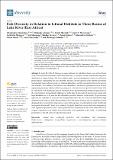| dc.description.abstract | In total, 28 of the 29 fish species reported from the Lake Kivu basin occur in the littoral zone of the lake, but information about their structure, occurrence, and the habitats affecting their distribution is largely lacking. The lake’s inshore area is poorly heterogenous, with rock and macrophyte habitats representing the major habitats. The lack of heterogeneity in the habitats is probably an important factor influencing species richness, abundance, and the association between the species and habitats. We evaluated the fish diversity, abundance, and habitat parameters across 14 sites representing the major habitats of the lake, using data collected between April 2018 and October 2019. We calculated Hull and Jaccard indices and applied uni- and multivariate statistical approaches to the collected data. We identified 18 fish species in the lake. In the north, 17 species were found, with high abundance in rocky sites but low abundance in sandy habitats. In the south, 15 species were reported. We identified 12 species in the Ishungu Basin where the site with rock substrate had high abundance and 13 species in the Bukavu Basin with weak species richness and low abundance across degraded sites. Lamprichthys tanganicanus, a non-native species, was abundant in rocky (north) and macrophyte sites (south). Sand, rock, conductivity, depth, dissolved oxygen, and water transparency were significant parameters that could explain the fish distribution in the north while dissolved oxygen, vegetation cover, depth, and conductivity were significant in the south. A monitoring programme of the fish fauna in Lake Kivu is needed. | en_US |

